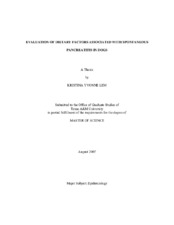| dc.description.abstract | This study estimates the association between dietary factors and spontaneous pancreatitis in dogs. A case-control study was conducted using 198 dogs with a clinical diagnosis of pancreatitis and 187 control dogs with a diagnosis of renal failure without clinical evidence of pancreatitis. Information on signalment, weight, body condition, dietary intake, medical history, diagnostic tests performed, concurrent diseases, treatment, length of hospital stay, and discharge status was extracted from medical records for dogs admitted to the Texas A&M University Small Animal Clinic (TAMU SAC) during January 2000 to December 2005. Information on dietary intake, signalment, weight, medical, surgical and environmental history was collected for the same dogs through a telephone questionnaire conducted from November 2006 through January 2007. Descriptive statistics were calculated, tabular analyses performed, and logistic regression was used to estimate odds ratios (OR) and 95% confidence intervals (CI). Based on information extracted from the medical records, ingesting unusual food (OR=4.3; CI=1.7 to 10.7), ingesting table food (OR=1.5; CI=1.0 to 2.2), or exposure to both of these dietary factors (OR=2.1; CI=1.3 to 3.2) increased the odds of pancreatitis. Collected through the telephone questionnaire, ingesting unusual food (OR=6.1; CI=2.2 to 16.5), ingesting table scraps the week before diagnosis (OR=2.2; CI=1.2 to 3.8) or regularly throughout life (OR=2.2; CI=1.2 to 4.0), and getting into the trash (OR=13.2; CI=2.1 to undefined) increased the odds of pancreatitis. Multivariable modeling estimated the associations of exposure to one or more dietary factors reported through the telephone questionnaire (OR=2.6; CI=1.4 to 5.0), overweight (OR=1.3; CI=0.7 to 2.5), year of diagnosis (OR=3.5; CI=1.9 to 6.5), neuter status (OR=3.6; CI=1.4 to 9.5), non-neuter surgery (OR=21.1; CI=3.3 to 133.9) and an interaction term between neuter status and non-neuter surgery (OR=0.1; CI=0.01 to 0.4). Dietary factors increase the odds of spontaneous pancreatitis in dogs. | en |


